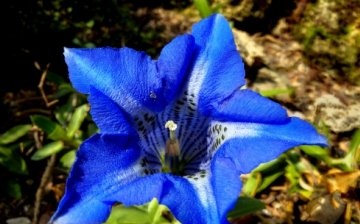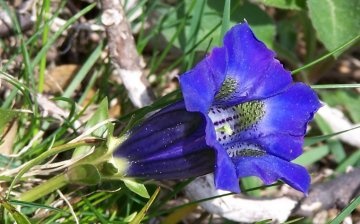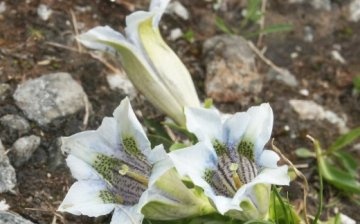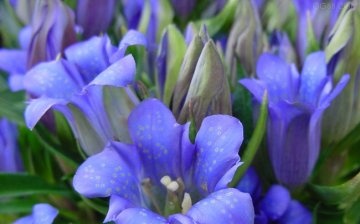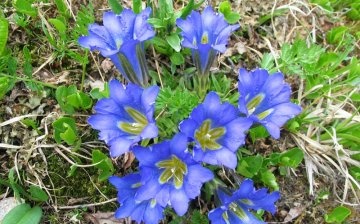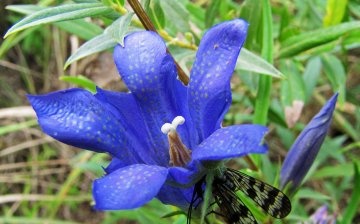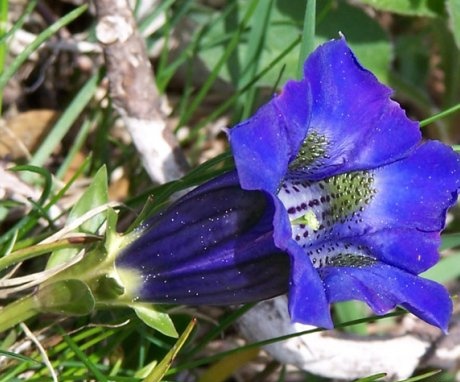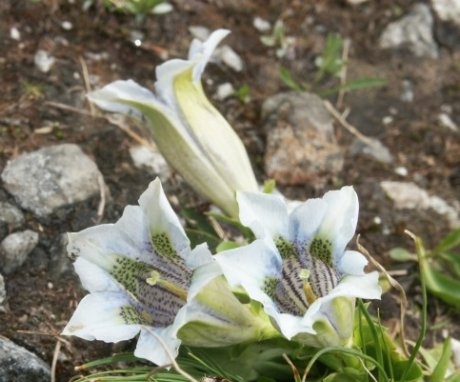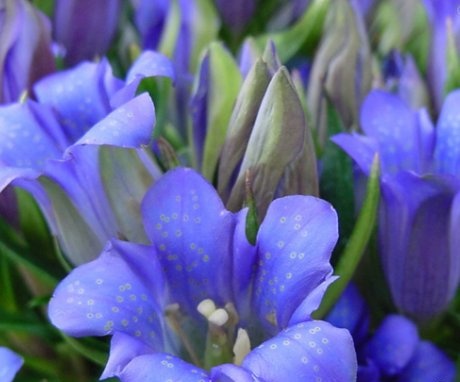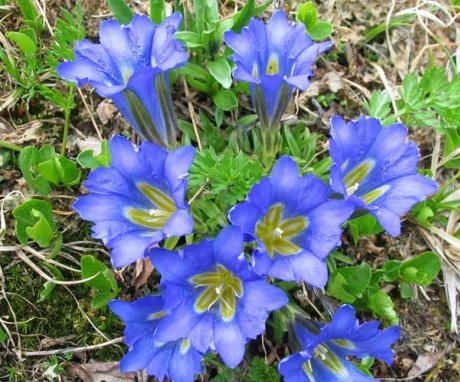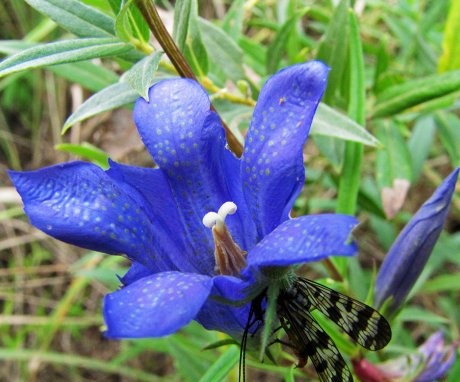Gentiana - popular varieties, cultivation and use
Gentiana grows almost throughout the entire globe. It is prized for the beauty of its lantern-like flowers. Florists especially like the fact that the bulk of the species and varieties of this plant are painted in a rather rare blue color of different shades.
Content:
Description of the plant
Gentian (gentian) belongs to the genus gentian gentian family. Gentian - this is the second name of the plant. The gentian genus has more than 400 plant species. There are annuals and perennials, growing vertically, in a bouquet, in a cascade, creeping.
The height of a gentian can be from 5 cm to 2 m. Gentian flowers are most often blue of various shades: from blue to purple. There are white, yellow, pink. There are two-tone types.
They resemble in shape bell.
There are spring and summer-autumn species of gentian. And in June they do not bloom. The gentian flower blooms for only a week. But there are many of them in the bush, so the time flowering the whole bush is long-lasting. Flowers close at night or in rainy weather, open early in the morning. Gentiana flowers are practically odorless.
Gentian varieties
Popular plant varieties:
- Gentiana semi-divided is an unpretentious plant that came to us from Asia. The height of the bush is 30 cm. It is covered with many flowers up to 7 cm in diameter, which are located on bending branches. There are up to 25 stems, and the number of flowers on them is about 200. The diameter of the bush reaches 40 cm. The flowers are purple-blue. Grown in the garden in rocky gardens, flower beds.
- Gentiana gentiana is a 60 cm high bush. Forms 10 shoots per year. Bell-shaped flowers with five petals are blue, rarely white. It blooms in late summer and early autumn.
- Pulmonary gentiana (sea bells) is used in folk medicine... It is a perennial shrub with several shoots, densely decorated with leaves.
- Gentiana tricolor is a shrub about 40 cm high. The flowers are blue, in the form of a glass, the size is 7 cm.
- Gentiana daurskaya has been cultivated by gardeners since the beginning of the 19th century. Grows wild in Dauria, Tibet. It has an oblique stem about 40 cm long. The flowers are large, dark blue. Grown in the garden in flower beds and cut.
- Gentiana Koha (stemless) grows in the mountains of Western Europe. The plant itself is small, up to 10 cm, and the flowers of blue, white, pink are huge in comparison with the stem. They reach 6 cm in diameter. A large number of dark spots are located inside the neck of the flower. Blooms in the second half of spring. The plant is used to create rock gardens.
- Gentiana Kluza looks like stemless, but its flowers are even larger.
- Decorated gentiana is a plant of the latest flowering line. It stretches from September to the end of December. The plant is not afraid of the first snow. The height of the bush is up to 15 cm, the flowers are pale blue. Grown in all climatic zones.
- Gentiana rough grows wild in the Far East and Asia. Perennial plant, medium height with several branches, at the ends of which are blue bells.
- Gentiana cruciform (cross-leaved) is a herbaceous plant with a small number of single stems with a large number of elongated leaves. Flowers outside are gray-green, inside - turquoise.
Many of these species have their own varieties, bred by breeders or created by nature. So the most famous hybrids of gentian gentian:
- Nikita with medium-sized azure flowers.
- The Blue Emperor is a short bush with bright blue flowers.
- Farorna is a plant with blue flowers adorned with a white corolla.
- Dark blue - blooms from August to October, brightly remove flowers with a dark stripe on the inside.
- Elizabeth Brand is a plant with short brown branches and long azure flowers.
Reproduction methods
Gentianu is propagated:
- Seeds
- By dividing the bush
- By cuttings
Gentian species differ in the shape of the stem. Therefore, they have different breeding methods. Small groundcover gentians reproduce well dividing the bush or cuttings new sockets. To do this, the bush is dug up, divided into three or four parts. You can plant in a permanent place immediately, if there is no threat that the plants will not have time to take root before winter. In areas where winter comes early, it is better to plant cuttings in the spring. Before that, it is better for them to grow in pots or a special greenhouse.
Tall, seven-part, Daurian so it is better not to breed. They have one root collar on which the buds are located. If damaged, it can fester, and the plant can die. Such species are best propagated by basal shoots. Break them out together with the "heel" in the spring when they reach a size of 5 cm. Root until the next season.
Some species take root easily on their own, without outside help. An example is the decorated Chinese gentiana. Almost all recumbent shoots grow by the next year and young plants are formed.
You can propagate the gentian of Chinese autumn species by cuttings up to 6 cm long.
They are cut to flowering, planted in a mixture of peat, sand and humus. High humidity is created, placed in partial shade. The later the plant begins to bloom, the longer it can be rooted. But you do not need to take cuttings with formed buds. A good result is the rooting of cuttings and species of seven-partite and lagodekhyana.
Propagate gentiana species such as the seven-partite, and seeds:
- In winter you need them stratify 5 weeks at a temperature of about 5 degrees. The seeds are sown in containers, but not plastic ones, because water usually stagnates in them. It is thoroughly disinfected.
- The soil is taken without weeds and infections. In composition, it should be suitable for this type.
- Sow the seeds on top of the soil. Cover with a very thin layer compost... Compacted a little.
- Watered very carefully, with a sprayer with a fine spray, so that the seeds are not washed off with a stream of water to one side of the pot.
- Cover with dark material or set in a dark place.
- A good result for most gentian species is given by placing dishes with sown seeds in a cold or light frost.
- After germination, the seedlings grow very slowly.
In the garden, you can create a new variety yourself by dusting the pistil of another with the pollen of one gentian. For this, a camel tassel is used. But the result is not always better than the original views.
Growing gentiana
Most gentian species grow only in a well-lit area. But there are those who do not tolerate direct sunlight. For example, gentiana seven-partite prefers light shading. Therefore, before planting, you need to inquire about the conditions of the natural habitat of the species.
Almost all types require frequent and abundant glaze and do not tolerate drought.
The soil for planting gentiana should be nutritious and well-drained. This is facilitated by the introduction of gravel into the soil. Indeed, in nature, it grows on rocky soil. The growing conditions for different gentian species are slightly different.So the stemless loves slightly acidic soil, and lime must be added under the Kluz gentian. The most undemanding to growing conditions is gentiana daurskaya. Grows in a sunny spot in any garden soil.
Plants grown from seed, in April (spring planting) or in September:
- Prepare a distance between the holes of 20 cm.
- Digging holes wide, three times wider than size root system plants with a lump of earth around it.
- Place the seedling in the middle of the hole.
- Crushed stone or stones are laid at the bottom, which will serve as drainage and protect the plant from waterlogging and stagnation of water in the root system.
- A small amount of soil is poured, watered, and compact the earth around the plant.
Gentiana, as a plant accustomed to living on rocky mountain slopes, is not very demanding on soil composition... Feed her mineral fertilizers for flowers, but in a lower concentration than indicated in the instructions. Some gentian with long stems, like the crotch, look great, cascading down from a hillock, a specially installed retaining wall.
Plant application
Like many plant species, gentianu was first used for treatment. Then gardeners appreciated the beauty of its flowers and began to grow it as an ornamental plant. There are about a hundred species that are used in gardening and medicine.
Gentianu is grown:
- In rock gardens
- In the flower beds
- In natural compositions
The medicinal properties of gentiana were noticed by the ancient Greeks. Since then, the extract and infusion of this plant have been used:
- As an anti-inflammatory agent.
- To combat helminths.
- Against cough.
- To strengthen the body.
The medicinal properties of most gentiana species are associated with its bitter taste. No wonder the plant is called gentian... This taste is given to the plant by glycosides, which are used to treat the stomach and intestines. These same substances relieve spasms.
In medicine, gentianu is used to create antiviral drugs.
The roots of the plant are rich in nutrients. They contain substances that are used in the production of medicines for cough, fever, insomnia. Pectins, insulin, ascorbic acid are part of gentiana. But not everyone can use drugs made from gentian. With an ulcer, hypertension, while carrying and feeding a child, you should refrain from using them.
To prepare the broth, the roots are washed, dried, and crushed. A tablespoon of the medicine is poured into a glass of water and boiled over low heat for 15 minutes. Strain. For half an hour of food intake, 3 times a day, take a tablespoon of broth.
More information can be found in the video:



